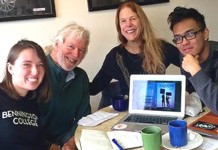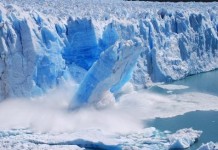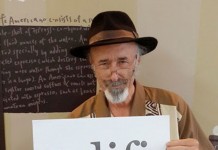 One of my mentors in the world of sci-fi literature is the SF novelist David Brin.
One of my mentors in the world of sci-fi literature is the SF novelist David Brin.
I once asked him about how climate change themes have been influencing sci-fi novels and movies, and he told me by email: “Global warming and flooding were important in my 1989 novel ‘Earth’ but they were earlier in the film ‘Soylent Green’ based on Harry Harrison’s novel ‘Make Room, Make room!'”
Well, with Brin and others leading the way, sci-fi isn’t going away from the literary scene by any means, but there’s a new kid on the block, and more and more colleges are offering classes on a rising new genre. Academia is waking up to the trials and tribulations of ‘cli-fi,’ and it’s a trend worth watching.
This spring semester five colleges nationwide have cli-fi lit classes on tap, with both undergrad and graduate level courses involved. And that’s just the tip of the iceberg. This year, 2015, is shaping up to be the Year of Cli-Fi in academia, and not just in North America, but in Britain and Australia as well.
With such publications as the New York Times (”College Classes Use Art to Brace for Climate Change”) and Time magazine reporting on the new genre in 2014, and with an Associated Press wire story going nationwide to 1,500 newspapers in December as well, several universities and colleges in the United States have taken up the call and are part of a telling new trend in higher education.
The Chronicle of Higher Education newspaper in Washington, D.C., which covers American academic issues in a variety of subject areas, has assigned a staff reporter to look into the rise of cli fi in the academy as well, according to sources.
Joining professors at Temple University in Philadelphia in the east and the University of Oregon out west, three other colleges are offering cli-fi courses this semester: Holyoke Community College in western Massachusetts, the University of Delaware and the State University of New York in Geneseo (SUNY Geneseo).
There is, of course, a long and storied history of teaching sci-fi at colleges across the country, with several universities even setting up literature departments that specialize in sci-fi research, writing and novels. Now cli-fi is joining the academic world and finding a room of its own there as well.
Elizabeth Trobaugh and Steve Winters at Holyoke Community College are team-teaching a climate-themed literature class this semester titled “Cli Fi: Stories and Science from the Coming Climate Apocalypse.”
When I told Trobaugh that I planned to write a news story about her course, she replied: “Thank you for your interest in what we are doing this semester. Professor Winters and I thought we were onto something, and your email confirms our conviction that cli-fi is indeed on the rise, and this is the moment (as Macklemore says in the song) to catch the wave.”
Stephen Siperstein, a doctoral student at the University of Oregon in Eugene who was profiled in the New York Times article last April, is also teaching a cli-fi literature class this semester, with his undergrad students posting weekly class blogs about what they are reading and how they are reacting to the new genre of fiction.
At Temple University, Ted Howell, also a doctoral student, is teaching an undergraduate class titled “Cli-fi: Science Fiction, Climate Change, and Apocalypse” with about 30 students enrolled. They are also keeping weekly blogs about the course, using them to interact online outside of class with their professor and fellow students.
“The first two texts we read this semester, ‘The Machine Stops’ by E.M. Forster and ‘The Time Machine’ by H.G. Wells, were written way before ‘climate change’ as we understand it was a real concern, but part of what I’m doing by assigning them is investigating what it means to talk about ‘climate change’ in books written in an earlier era,” Howell said in an email.
At SUNY Geneseo in upstate new York, Professor Ken Cooper is teaching a class this semester titled “Reader and Text: Cli-Fi”.
We will begin by analyzing some print and electronic texts from the emergent genre of ”cli-fi”: renditions of the present and future inflected by anthropogenic climate change,” Cooper told his students by way of introduction. ”Representative works may include Paolo Bacigalupi’s ‘The Windup Girl,’ Barbara Kingsolver’s ‘Flight Behavior,’ Cuaron’s ‘Children of Men,’ and the Cape Farewell/ADRIFT project. There will be at least one zombie apocalypse.”
Professor Siohban Carroll at the University of Delaware is a specialist in 19th century British literature, and told me in a recent Tweet: “I’m sort of teaching a 19th Century ‘cli-fi’ class right now at the graduate level. This week: Mary Shelley and the Anthropocene.”
Image credit: “College Prep Harkness Table” by The College Preparatory School – the College Preparatory School http://www.college-prep.org/about/facilities-project/index.aspx. Licensed under CC BY 3.0 us via Wikimedia Commons.


































UPDATE: one of the students in Professor Stephen Siperstein’s class mentioned in this article above blogs this personal post on the class blog today: — ”I think that Climate Change Fiction is a great new up and coming genre of literature that has the power to change the world. We are at a time right now where the decision we make as a planet will determine the fate of Earth. Either we try to rescue it by cutting carbon dioxide emissions, or we just keep doing what we’re doing and destroy it. The beauty of cli-fi, however, is that is has the ability to influence people’s decisions.
In an article by Sarah Holding, she talks about her motivations for writing cli-fi. What I find most interesting, and applicable to what we have talked about in this course, is how she wants to connect children with the environment and mother earth. Because we can’t all go and see the polar ice caps melting first hand, by writing cli-fi short stories, she can convey the same message to her audience. This is crucial to the health of our planet because the involvement and passion from the younger generations is the future of our planet. By connecting these children with cli-fi, it will help motivate them to make a positive impact on the world. I also enjoyed the fact that Holding uses her work as a contribution to stopping global warming. Throughout this course, I have had the image that in order to stop global warming everybody needs to physically contribute in one way or another. After reading this article, I discovered that there are so many ways in which people can help prevent global warming from getting worse. From making videos, to writing novels, to leading campaigns, there are so many different ways to contribute to the cause.
In an interview with Dan Bloom, I found it very interesting how there was a discussion about what makes cli-fi actually cli-fi. Similarly, in class, we have had very similar discussions in which we compared the similarities of all the short stories, and various kinds of cli-fi stories we have read over the course of the term. It was interesting to read Bloom’s response and compare them to our class discussions and see the similarities and differences. What I likes about Bloom’s response is that he acknowledges that cli-fi is meant to be open to interpretation. There is no set medium or discourse in which these stories have to be written—they can be created in whatever way maximizes their effectiveness. This is inspirational because it opens up the genre to unlimited creativity. Through videos, podcasts, art, stories, novels, games, and many more, the world can be exposed to cli-fi. Additionally, I found Bloom’s response interesting when asked about how now was the critical time for cli-fi. He agreed that the time was now to act. The issues are already hitting the world, so we need to act immediately…if were not already too late. The temperature is already rising which will lead to increasing sea levels. This will have worldwide effects that will devastate large cities worldwide. In order to save our world, immediate action needs to take place, and cli-fi is just the first step. In order to create action, cli-fi authors need to create awareness and emotion that will drive people to action. This is the eventual goal, and hopefully we have left ourselves enough time to minimize the effects of climate change.
”
Dr Robin Murray, Professor at EIU adds this: …”Good article. I’ve taught several film and the environment courses here at Eastern Illinois University. I’ve taught film and literature courses highlighting everyday eco-disasters and environmental cartoons. I also taught a studies in film course entitled Monstrous Nature in spring 2014. This semester I’m teaching history of cinema, a gen ed course, but will have sections on cli-fi. I’m also teaching a Multicultural American literature course with a unit on Linda Hogan and ecofeminism. Although I’ll be on sabbatical in the fall, I plan to teach a cli-fi studies in film course in the spring next year. We’re trying with our film studies minor. I’ve proposed a senior seminar focused on documentary and society. When I teach it, it will be an eco cinema course : ) ”
Brief UPDATE : Professor Darragh Martin will teach a ”cli fi” lit class at Columbia University in NYC summer session this summer begins May 27. Registration open now. Details online.